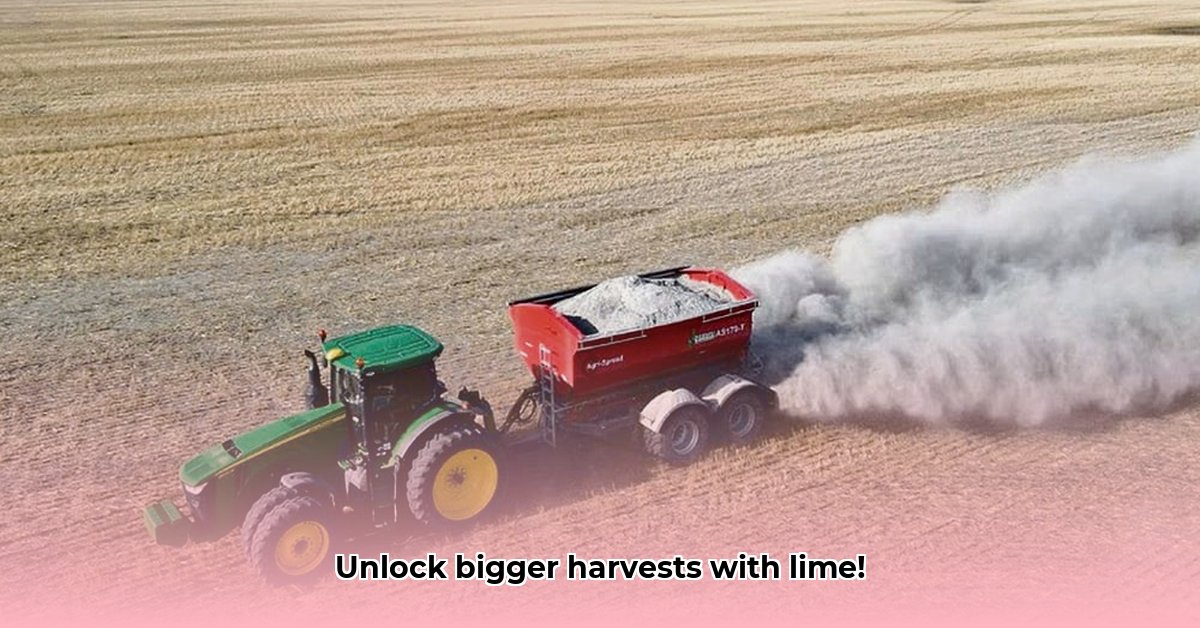
Ready to unlock the full potential of your crops? Improving your soil health is the key, and agricultural lime, readily available at Tractor Supply Co., plays a crucial role. This guide will empower you to choose between dolomitic limestone and gypsum, apply them effectively, and monitor their impact on your farm's sustainability. For more information on pellet lime, check out this helpful resource.
Understanding Your Soil: The Foundation of Success
Think of your soil as a dynamic ecosystem. Just as healthy food fuels you, healthy soil nourishes your plants. Nutrient deficiencies and pH imbalances can severely limit crop yields. Ignoring these issues directly impacts your harvest. That's where soil testing comes in.
Soil Testing: Your Soil's Checkup
Before applying any amendments, conduct a comprehensive soil test. This involves collecting soil samples from various parts of your field and sending them to a reputable lab for analysis. The results will reveal your soil's pH, nutrient levels (including calcium and magnesium), and other vital indicators, guiding your amendment choices and application rates. Many local agricultural extension offices provide affordable or free soil testing services. Isn't knowing the precise needs of your soil crucial for optimal yields?
Soil Amendments: Dolomitic Limestone and Gypsum
Two effective soil amendments readily available at Tractor Supply Co. are dolomitic limestone and gypsum. They address distinct soil challenges:
Dolomitic Limestone: The pH Balancer
Dolomitic limestone primarily neutralizes soil acidity. Excessive acidity hinders nutrient uptake and can negatively impact plant growth. This amendment provides both calcium and magnesium, essential nutrients often deficient in acidic soils. Does your soil test reveal an acidic pH and low calcium or magnesium levels? If so, dolomitic limestone is your solution.
Gypsum: The Soil Structure Improver
Gypsum, or calcium sulfate, improves soil structure and drainage. It's particularly beneficial for clay soils prone to compaction—compacted soil limits root growth and water infiltration. Gypsum enhances water penetration, aeration, and root development, resulting in healthier plants and improved yields. Is poor drainage or compaction hindering your crop production? Gypsum can help solve these problems.
Choosing the Right Amendment: A Practical Guide
The decision between dolomitic limestone and gypsum hinges on your soil's specific needs, as revealed by your soil test. The following table provides a helpful guide:
| Soil Condition | Best Amendment | Rationale |
|---|---|---|
| Low pH (Acidic) | Dolomitic Limestone | Raises pH, supplies calcium and magnesium, improves nutrient availability. |
| High Salinity | Gypsum | Improves drainage, reduces sodium concentration, enhances soil structure. |
| Poor Drainage/Compaction | Gypsum | Improves water infiltration, reduces compaction, promotes root development. |
| Calcium Deficiency | Dolomitic Limestone or Gypsum | Both provide calcium, but dolomitic limestone is a richer source of magnesium. |
Applying Amendments: A Step-by-Step Guide
Correct application is vital for maximizing the benefits of your chosen amendment. Follow these steps:
- Prep Work: Clear the field of any debris which could interfere with even spreading.
- Even Spreading: Use a spreader designed for agricultural lime to ensure uniform distribution. Carefully follow the application rates based on your soil test results—over-application can be detrimental.
- Incorporation: Till or disk the amendment into the soil to ensure thorough mixing and optimal contact with soil particles. If you are applying to already established crops, avoid working in directly around them.
- Timing: Spring or fall application is generally recommended, allowing sufficient time before planting.
Monitoring and Maintenance: Long-Term Soil Health
Soil amendment isn't a one-time fix; it's an ongoing management practice. Regular monitoring is essential to assess the effectiveness of your chosen amendment and make necessary adjustments to maintain healthy soil.
- Post-Application Soil Testing: Conduct another soil test a few months or after the growing season to evaluate the impact of your amendment.
- Crop Monitoring: Regularly observe the health and growth of your crops to gauge the effectiveness of the amendment.
- Adaptive Management: Adjust application rates and strategies based on soil test results and crop performance.
Troubleshooting: Addressing Common Challenges
Even with proper application, unforeseen issues can arise. If your crops continue to exhibit signs of nutrient deficiency or poor growth, consult your local agricultural extension office, or other trusted agricultural experts.
Resources: Your Partners in Sustainable Agriculture
Your local agricultural extension office or university agricultural department provides invaluable resources, including soil testing services, expert advice, and sustainable farming practices. Leverage these resources to optimize your soil health and crop yields.
Remember, careful soil testing and adaptive management are paramount to maximizing the benefits of agricultural lime, leading to sustainable and profitable agricultural practices.